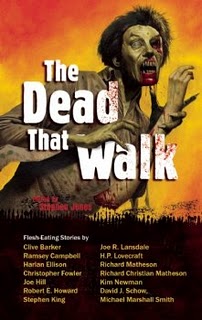Permuted Press, 2005, ed. D. L. Snell & Elijah Hall
Permuted Press is a U.S small press that in the past has dedicated itself almost entirely to zombie fiction, which - in my book - is extremely cool. However, despite my being a vocal fan of both small press and zombies, it’s taken me a while to pick up a copy of this anthology: I’ve recently read so much bad U.S small press horror (by virtue of the U.S small press market being so vast – see Sturgeon’s Law) that my expectations of such a specialised small press offering were extremely low, to say the least.
Well, I’m delighted to say that this anthology is great fun to read, and will undoubtedly please most fans of Romero-esque zombies.
Of course, that last comment brings me directly to my only major criticism of the anthology: the tales herein revolve exclusively around the variety of flesh-eating zombie beloved of film-maker George Romero. Not that there’s anything wrong with that in itself. I, like many others, am a huge fan of the so-called ‘Pittsburgh’ zombies, and this is the market that the anthology is aimed at. Having said that, however, this narrowing of the field (which ignores zombies from voodoo, EC Comics and other backgrounds) does make for an anthology in which many of the stories achieve a slightly bland ‘sameness’. This is not to say that the quality of the individual stories is poor: barring a couple of notable exceptions which read like poorly-edited fan fiction, most of the tales are well-written, engaging, and – yes – frightening. However, the subject matter – not to mention the original movies from which these tales have in part been drawn, and which therefore set certain specific expectations for readers – seriously restricts the creativity of the authors. By the time I’d finished the fourth 'survivor-of-apocalyptic-zombie-uprising-struggles-to-cope' story, I was beginning to feel that each piece – regardless of its strengths – was really just readdressing specific elements of the various Romero flicks. Aside from introducing a certain degree of blandness, this also gave some of the stories a ‘vignette’ feel, as though they were supposed to be part of some larger work (this is almost literally true in the case of David Wellington’s
‘Chuy and the Fish’ and David Moody’s
‘Home’, which are both set in the worlds of those authors’ respective previously-published zombie novels). This may also be down to the originating material, as the Romero movies deal with zombies on an epic scale, and allow for levels of emotional and plot development that shorter forms simply can’t achieve.
Of course, it’s unlikely that the restrictions I’ve mentioned will worry die-hard P-zombie fans, but anyone looking for a slightly broader range may be slightly disappointed. That said, even the ‘same-old’ stories were for the most part enjoyable, and those that strove for something more were often outstanding.
And so: the highlights.
‘Hotline’, by Russell A. Calhoun, is a neat little story about a zombie clean-up squad, with a twist in the tale that takes the reader instantly from ‘same-old’ territory to somewhere much nastier. To say more than this would give too much away.
Meghan Juraldo’s
‘Dead World’ turns the standard zombie apocalypse scenario on its head by presenting from the zombie’s point-of-view. It’s a darkly humorous piece that doesn’t necessarily offer any definitive answers to the oft-asked questions (Why do they come back? Why eat human flesh?), but gets full marks for tackling them from the other side of the fence.
‘13 Ways of Looking at the Living Dead’, by David Pape, is a rather beautifully poetic collection of vignettes that do exactly what the title suggests. Purportedly collected by a ‘survivor’ in an effort to explain the zombie phenomenon, the various pieces tackle the themes of life, death, loss, desire, and even nekkid girls in horror movies, in a style that alternates between clinical and emotional. A very impressive offering.
David Dunwoody’s
‘Grinning Samuel’ revolves around a very ‘different’ P-zombie, whose chief desires – despite his obvious predilection for carnage – are somewhat more practical than usual. An intriguing mixture of horror, steampunk and action (with a touch of New Weird), this story defeats reader expectations at every turn. I can only pray that Dunwoody turns his talents to penning a complete novel set in Samuel’s world – this is one of the best zombie tales I’ve ever read, and I want more!
‘Undead Prometheus’, by Rob Morganbesser, puts an interesting spin not upon the zombies in his tale, but upon the chief protagonist, a well-known figure drawn from horror literature (and if the title doesn’t give it away, you haven’t read the classics!). Taking Romero’s proclamation ‘They’re us’ and examining it from the point-of-view of someone who is neither ‘us’ nor ‘them’, this piece doesn’t necessarily offer anything startlingly new, but at least changes the window-dressing in a manner that generates interest.
Andre Duza’s
‘Like Chicken for Deadfucks’ (which actually is lifted from a larger work, but nonetheless stands exceptionally well on its own) depicts a future noir in which electrified fences keep the zombies at bay, as they would any other urban annoyance, allowing the cops and citizens of the big city to concern themselves with the far nastier problems occurring on this side of the barriers. An exciting blend of action, cyberpunk and horror, this story simultaneously concludes the anthology and points the zombie menace off into new directions.
All in all, this is an extremely enjoyable anthology, with good content and decent production values. Definitely worth owning if you’re a fan of zombies in film or fiction.


































